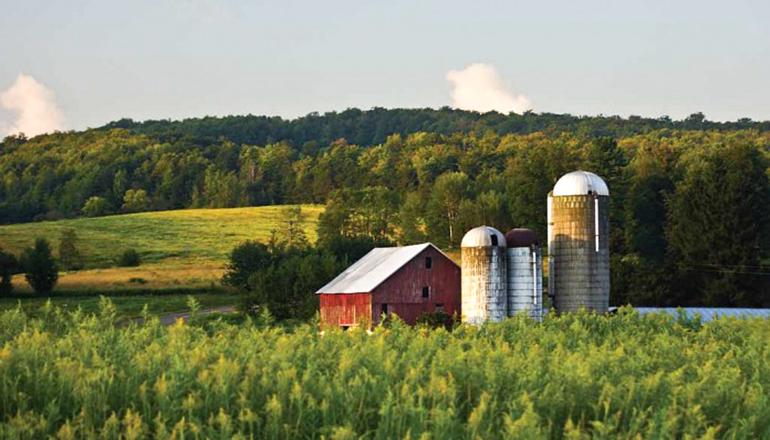(Missouri Independent) – U.S. farm income is falling from record highs as low commodity prices, trade headwinds, and higher costs squeeze profits, according to a new report from the University of Missouri.
The 2024 U.S. Agricultural Market Outlook report released Tuesday by the Food & Agricultural Policy Research Institute, also known as FAPRI, is a 10-year projection of the agriculture economy. It examines production trends and pricing for commodity and specialty crops and livestock and discusses issues like interest rates, consumer prices, and biofuel production that impact farming as a whole.
For producers, the news isn’t especially welcome.
“We got lower commodity prices kind of across the board, except for cattle,” said Pat Westhoff, the agricultural economics professor who serves as the institute’s director.
The annual report is eagerly anticipated in the agriculture industry and its findings have extra significance this year as Congress tries to pass a farm bill renewing producer support and food distribution programs.
Net farm income nationally is expected to be about $118.2 billion this year, down from a record of about $162 billion in 2022.
Westhoff said he briefed Congressional staff on the report Tuesday and the reaction was a classic glass half-empty, glass half-full split. Some saw the large decline in farm income as a problem, while others noted that income is expected to remain above the average from 2015 to 2019.
“People were using the same numbers and making the opposite arguments,” Westhoff said.
Missouri is second only to Texas in the number of farms, with 87,887 farms that sold $14.7 billion in agricultural products in 2022, up from $10.5 billion in 2017 according to the Census of Agriculture. Missouri farms also received nearly $1 billion in government payments or other income.
With farm production expenses of $10.7 billion, Missouri farms had a net cash income of $5 billion.
The 5,596 largest Missouri farms, with sales of $500,000 or more, sold more than $11.6 billion of products in 2022. The 67,400 Missouri farms with sales of less than $50,000 sold $685 million in agricultural products.
Prices for grain and oil crops have fallen dramatically in the past year. Missouri farmers were receiving $14.90 a bushel for soybeans in January 2023, and $6.94 a bushel for corn. According to the monthly agricultural prices report from the National Agricultural Statistics Service, the price received for soybeans in January was $12.90 a bushel and for corn, it was $4.79.
The issues facing farmers nationally, Westhoff said, are true in Missouri, where corn, soybeans, and wheat are the major cash crops.
The FAPRI report projects the decline in commodity grain prices will slow, but continue.
Missouri farmers get a slightly better price than the national average for corn and soybeans because of proximity to large rivers and industries such as ethanol and biodiesel that buy commodities locally, Westhoff said.
“Where you have crushing facilities for soybeans matters tremendously,” Westhoff said. “Where you have ethanol plants matters as well.”
Missouri produced 264.9 million bushels of soybeans in 2023. A decline of $2 per bushel means the farmers producing those beans received more than $500 million less than they did for the same commodity the previous year.
The sharp decline in market prices for soybeans hasn’t been accompanied by a similar decline in prices for fertilizer, fuel, and other supplies, said Casey Wasser, chief operating officer of Missouri Soybeans, the industry lobbying association.
“The input prices have not come down at all with the other prices,” Wasser said. “So that’s where that net farm income is going to hit producers pretty tight.”
Missouri has the nation’s sixth-largest cattle herd. It also is home to the sixth largest number of hogs, and its farmers sold the seventh largest number of chickens for meat consumption and had the nation’s 12th largest flock of laying hens.
But Missouri is losing farmers – and farmland – faster than the national average.
The number of farms declined 7.8% since the 2017 farm census while nationally the number fell 6.9%. Nationally, 2.2% of farmland was converted to other uses between the surveys, while in Missouri the acreage in farming declined 2.7%.
The smallest producers are being squeezed the tightest, said Tim Gibbons of the Missouri Rural Crisis Center. In a telephone interview, after he spent a day lobbying in Washington for changes in national farm programs, Gibbons said the issues facing farmers go well beyond commodity prices and interest rates.
Control of agriculture continues to be concentrated in large corporations, he said. Farm programs are designed to support cheap commodities and large producers, he said.
“What I’m hearing on the Hill is a joke relative to the situation that is farming in Missouri and the United States right now,” Gibbons said.
Corporate-backed buyers are outbidding local residents for farmland and the concentration in meatpacking means producers become dependent on contracts that can be canceled when profits narrow. The decision by Tyson Foods to close a plant in Perry, Iowa, that employs 1,300 people will have a ripple effect on the farmers who raise hogs under contract, Gibbons said.
Missouri has lost more than 1,000 cattle producers a year over the past 25 years, a trend that accelerated to about 2,000 per year in the past five years, according to the farm census. The number of farms producing hogs has declined from 12,133 in 1992 to 2,184 in 2022.
“The policies that have been in recent past farm bills have been written by and for these multinational corporations and lobbyists that lobby for them,” Gibbons said. “We need a very different vision and a farm bill.”
The only area where prices have increased in the past year is for cattle. That’s because the national herd is at its lowest number since the 1960s, in large part due to pastureland drying up because of droughts starting in 2020.
Short supplies are pushing prices up.
“It’s causing liquidation and we’re not seeing rebuilding right now,” Gibbons said. “That connects with interest rates as well.”
Higher interest rates in the United States, which increase costs for farmers as they borrow to finance annual operations or add land and equipment, put farmers at a disadvantage internationally by making the dollar worth more in exchange, Westhoff said.
One indicator of the impact is that the U.S. has become a net importer of food and agricultural products, reversing decades of a surplus in the balance of farm trade.
“We are importing lots of value-added products that might otherwise be produced here and of course that has spillover effects,” Westhoff said.
The FAPRI report section on government aid to farmers notes that the cost of the two main programs intended to shore up prices – agricultural risk coverage, or ARC, and price loss coverage, or PLC fell below $1 billion because of recent high commodity prices.
At the same time, crop insurance payments in 2023 totaled $9.3 billion.
“We need to figure out a system of farmer-owned grain reserves and price floors and price ceilings to stop the volatility of the market, and keep that price floor at the cost of production,” Gibbons said.
Missouri Soybean is pushing for changes in federal farm support programs to reset the protected prices at a higher level, Wasser said. Prices on beans could fall another $2 per bushel and Missouri farmers wouldn’t qualify for payments to make up any of the difference, he said.
“We’re still not even close to a safety net, with inputs and $11 beans it’s tough for any farmer no matter what your size or your leverage to be making any profit on that,” Wasser said.
FAPRI’s job is to provide information, not advise on policy decisions, Westhoff said.
The difficulty of getting changes to the programs is cost, he said.
Some “would like to do some changes that would improve the safety net from the perspective of producers but those changes all cost money,” he said. “And unless you’re going to reduce that spending or reduce spending on conservation programs, there’s not any obvious way to put those pieces together.”
The decline in commodity prices should ease inflation in food costs and even reverse some recent increases, such as for eggs and pork, Westhoff said. Food purchased for consumption at home should not increase any faster than inflation generally, the report indicates.
But consumers shouldn’t expect everything in the supermarket to get cheaper, he said.
“For the most part, the share of those commodity prices that affect consumer food prices is pretty small,” Westhoff said. “Therefore even a significant decline in the farm level price doesn’t translate to any decline, or not a very big decline, in grocery store prices.”


